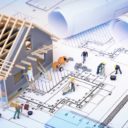U.S. homebuilder confidence leveled off in November after a consecutive 2-month drop, but according the National Association of Home Builders consistent home demand was stifled by potential future budget battles in Washington.
The NAHB/Wells Fargo Housing Market Index released Monday measured in at 54 in the month of November. The October figure was downwardly revised to 54 from the originally reported 55.
Economists polled by Reuters were not far off in their expectations, predicting a reading of 55 for the month of November.
“Given the current interest rate and pricing environment, consumers continue to show interest in purchasing new homes, but are holding back because Congress keeps pushing critical decisions on budget, tax and government spending issues down the road,” read the statement released by the Washington-based industry group’s chairman, Rick Judson.
Judson also claimed that homebuilder confidence was also stifled by rising construction costs and low appraisals. Yet, the index has held above 50 for 6 straight months. In reading the index, measurements below 50 mean more homebuilders view market conditions as poor than favorable.
“The fact that builder confidence remains above 50 is an encouraging sign, considering the unresolved debt and federal budget issues cause builders and consumers to remain on the sideline,” NAHB Chief Economist David Crowe said in the same statement from the group.
Even though many will solely scapegoat the potential for future impasse in Washington, the increase in mortgage rates this summer due to the Fed potentially scaling back on their easy money policy has been largely responsible for the brakes being put on the housing recovery.
In truth, if mere rumors have the power to rock the sector in such as manner, then the housing market is weak, propped up only by monetary policy pressured by the Obama administration.
Mortgage rates climbed to 2-year highs in August on mere rumor-induced fears that the Federal Reserve may have been considering reducing its $85 billion monthly purchases of Treasuries and mortgage-backed securities in September. Though the Fed cited improvement in the labor earlier this year, they are largely afraid of inflation. But the labor market proved to fragile, with labor force participation now remaining at a 35-year low.
Obviously, central bank officials decided against tapering its bond-purchase stimulus 2 months ago, and have since done everything in their power to downplay rumors they will consider such a move before sometime in 2014.
“In short, the report still implies net improvement in sales relative to before mortgage rates started to rise in May, but activity has stalled in the last few months,” Jim O’Sullivan, chief U.S. economist at High Frequency Economics wrote in a research note.
The survey’s index on homebuilders’ views on current sales conditions held steady for a second month at 58, the industry group said.
The gauge of expectations for single-family home sales for the next six months fell for a third straight month to 60 from a downwardly revised 61 in October, which was again, initially reported incorrectly at 62.
The component on prospective buyer traffic dropped to 42, which is now the lowest since we have seen since June. It was downwardly revised to 43 last month. The October reading was also initially reported incorrectly at 44.
Midwest homebuilders reported the most significant drop in confidence. The Midwest region’s sentiment fell all the way to 54 points in November from a 62 reading in October. The index’s three-month average fell to 60 from 63.
The Northeast region, however, showed the biggest improvement in homebuilder sentiment. The NAHB index for the Northeast region rose to 44 from what was an 11-month low of 30, increasing its three-month average to 39 from 38.






